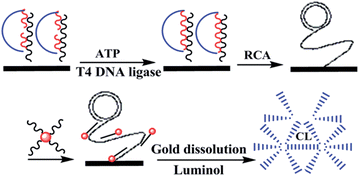A cascade amplification strategy based on rolling circle amplification and hydroxylamine amplified gold nanoparticles enables chemiluminescence detection of adenosine triphosphate
Abstract
A highly sensitive and selective chemiluminescent (CL) biosensor for adenosine triphosphate (ATP) was developed by taking advantage of the ATP-dependent enzymatic reaction (ATP-DER), the powerful signal amplification capability of rolling circle amplification (RCA), and hydroxylamine-amplified gold nanoparticles (Au NPs). The strategy relies on the ability of ATP, a cofactor of T4 DNA ligase, to trigger the ligation-RCA reaction. In the presence of ATP, the T4 DNA ligase catalyzes the ligation reaction between the two ends of the padlock probe, producing a closed circular DNA template that initiates the RCA reaction with phi29 DNA polymerase and dNTP. Therein, many complementary copies of the circular template can be generated. The ATP-DER is eventually converted into a detectable CL signal after a series of processes, including gold probe hybridization, hydroxylamine amplification, and oxidative gold metal dissolution coupled with a simple and sensitive luminol CL reaction. The CL signal is directly proportional to the ATP level. The results showed that the detection limit of the assay is 100 pM of ATP, which compares favorably with those of other ATP detection techniques. In addition, by taking advantage of ATP-DER, the proposed CL sensing system exhibits extraordinary specificity towards ATP and could distinguish the target molecule ATP from its analogues. The proposed method provides a new and versatile platform for the design of novel DNA ligation reaction-based CL sensing systems for other cofactors. This novel ATP-DER based CL sensing system may find wide applications in clinical diagnosis as well as in environmental and biomedical fields.


 Please wait while we load your content...
Please wait while we load your content...